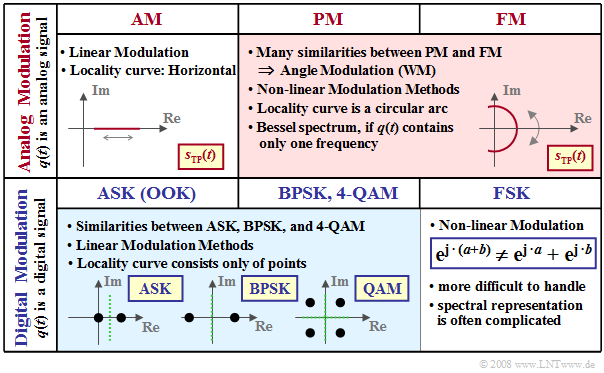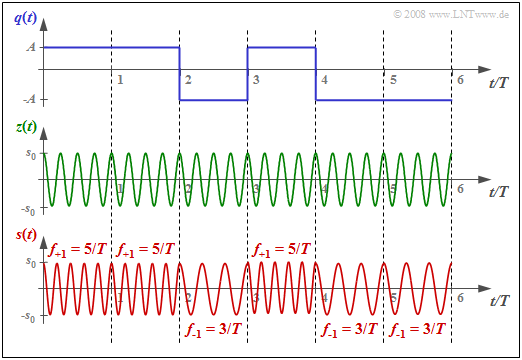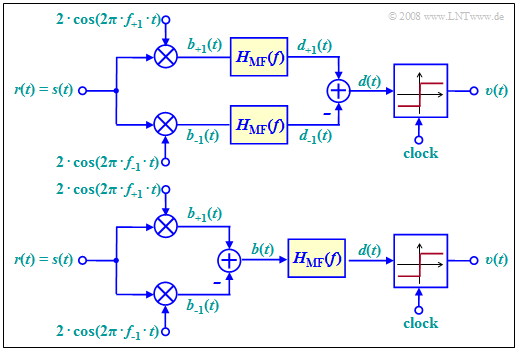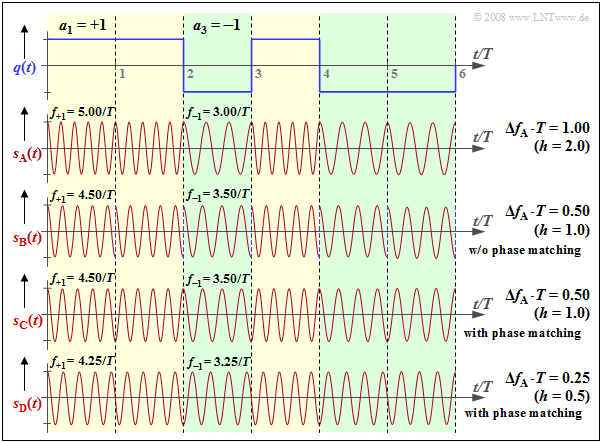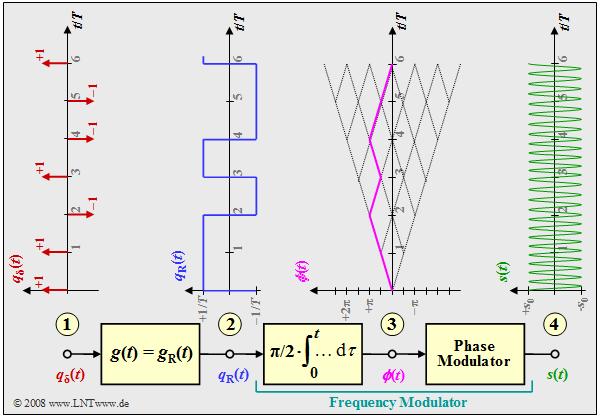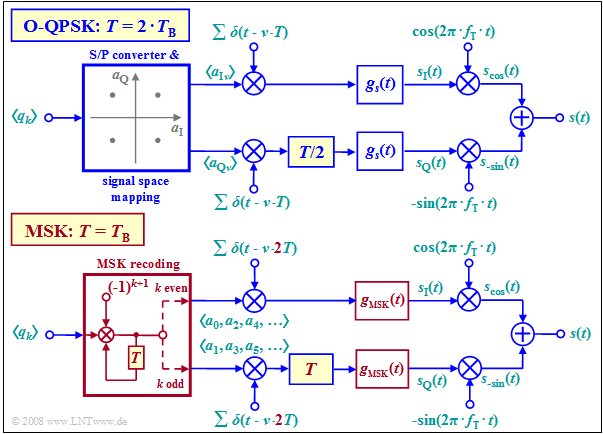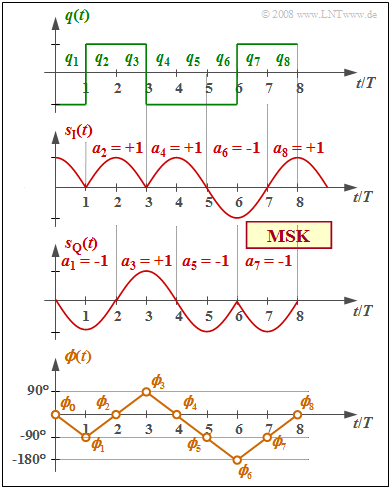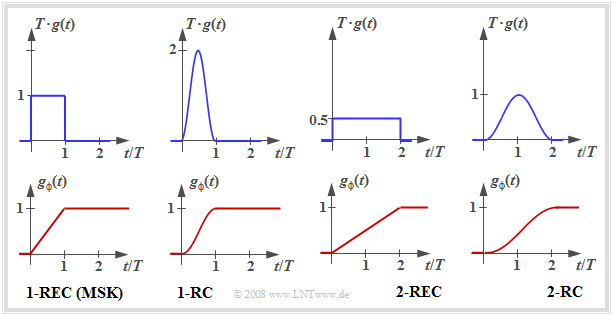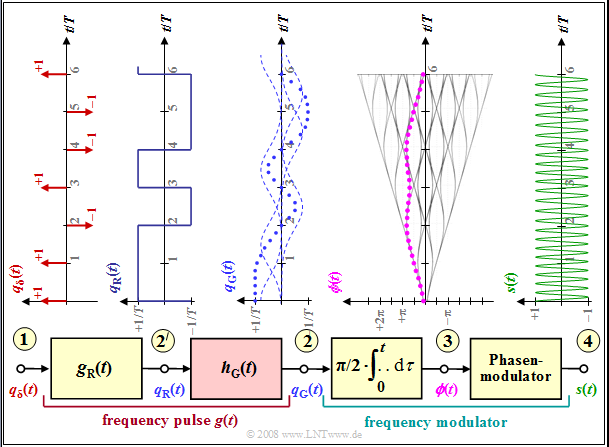Difference between revisions of "Modulation Methods/Non-Linear Digital Modulation"
| Line 191: | Line 191: | ||
[[File:EN_Mod_T_4_4_S6.png | right|frame| Block diagram for generating a MSK signal]] | [[File:EN_Mod_T_4_4_S6.png | right|frame| Block diagram for generating a MSK signal]] | ||
| − | *the digital source signal at point '''(1)''', a sequence of Dirac impulses '''KORREKTUR: delta pulses''' spaced by $T$, weighted by the coefficients $a_ν ∈ \{–1, +1\}$: | + | *the digital source signal at point '''(1)''', a sequence of Dirac impulses '''KORREKTUR: Dirac delta pulses''' spaced by $T$, weighted by the coefficients $a_ν ∈ \{–1, +1\}$: |
:$$q_\delta(t) = \sum_{\nu = - \infty}^{+\infty}a_{ \nu} \cdot \delta (t - \nu | :$$q_\delta(t) = \sum_{\nu = - \infty}^{+\infty}a_{ \nu} \cdot \delta (t - \nu | ||
\cdot T)\hspace{0.05cm};$$ | \cdot T)\hspace{0.05cm};$$ | ||
Revision as of 16:23, 11 January 2023
Contents
- 1 Properties of non-linear modulation methods
- 2 FSK – Frequency Shift Keying
- 3 Coherent demodulation of FSK
- 4 Error probability of orthogonal FSK
- 5 Binary FSK with Continuous Phase Matching
- 6 MSK – Minimum Shift Keying
- 7 Realizing MSK as Offset–QPSK
- 8 General Description of Continuous Phase Modulation
- 9 GMSK – Gaussian Minimum Shift Keying
- 10 Exercises for the chapter
- 11 References
Properties of non-linear modulation methods
All modulation methods can be alternatively classified as:
- amplitude, phase and frequency modulation,
- analog and digital modulation methods,
- linear and non-linear modulation methods.
Considering this last distinction, the following definition applies:
$\text{Definitions:}$
- A »linear modulation method« is present if any linear combination of signals at modulator input leads to a corresponding linear combination at its output.
- Otherwise, it is a »non-linear modulation«.
At the "beginning of the present book" it was already pointed out that the main difference between an analog and a digital modulation method is that
- in the first one an analog source signal $q(t)$ is present, and
- in the second one a digital signal.
However, a closer look will reveal that there are a few more differences between these methods. This will be discussed in more detail below.
The following diagram shows some of the differences with respect to the classifications given above.
- $\text{Analog amplitude modulation}$ $\rm (AM)$ is a linear method. The locus curve - that is, the equivalent low-pass signal $s_{\rm TP}(t)$ represented in the complex plane - is a straight line.
- Many similarities between $\text{analog phase modulation}$ $\rm (PM)$ and $\text{analog frequency modulation}$ $\rm (FM)$ ⇒ common description "angle modulation" (German: "Winkelmodulation") $\rm (WM)$.
- In that case, the locus curve is an arc of a circle. With a harmonic oscillation, there is a line spectrum $S(f)$ at multiples of the message frequency $f_{\rm N}$ around the carrier frequency $f_{\rm T}$.
- $\text{Digital amplitude modulation}$, referred to as either "Amplitude Shift Keying" $\rm (ASK)$ or as "On–Off–Keying" $\rm (OOK)$, is also linear. In the binary case, the locus curve consists of only two points.
- Since $\text{binary phase modulation}$ $($"Binary Phase Shift Keying", $\rm BPSK)$ can be represented as $\rm ASK$ with bipolar amplitude coefficients, it is also linear. The shape of the BPSK power-spectral density is essentially determined by the magnitude square spectrum $|G_s(f)|^2$ of the basic transmission pulse.
- However, this also means: The BPSK spectrum is continuous in $f$, unlike the analog PM of a harmonic oscillation (only one frequency!). If one were to consider BPSK as analog PM with digital source signal $q(t)$, then an infinite number of Bessel line spectra would have to be convolved together to calculate the power-spectral density ${\it Φ}_s(f)$ when $Q(f)$ is represented as an infinite sum of individual frequencies.
- Since $\text{quadrature amplitude modulation}$ with four signal space points $\rm (4–QAM)$ can also be described as the sum of two mutually orthogonal, quasi-independent BPSK systems, it too represents a linear modulation scheme. The same applies to the $\text{higher-level QAM methods}$ such as $\rm 16–QAM$, $\rm 64–QAM$, ...
- Higher-level "Phase Shift Keying", such as $\rm 8–PSK$, is linear only in special cases, see [Klo01][1]. Digital frequency modulation $($"Frequency Shift Keying", $\rm FSK)$ is always non-linear. This method is described below, where we restrict our focus to the binary case $\rm (2-FSK)$ .
FSK – Frequency Shift Keying
$\text{Now we assume:}$
- the transmitted signal of the analog frequency modulation,
- $$s(t) = s_0 \cdot \cos\hspace{-0.05cm}\big [\psi(t)\big ] \hspace{0.5cm} {\rm with} \hspace{0.5cm} \psi(t) = 2\pi f_{\rm T} \hspace{0.05cm}t + K_{\rm FM} \cdot \int q(t)\hspace{0.1cm} {\rm d}t,$$
- the rectangular binary source signal with $a_ν ∈ \{+1, –1\}$ ⇒ bipolar signaling:
- $$q(t) = \sum_{\nu = - \infty}^{+\infty}a_{ \nu} \cdot g_s (t - \nu \cdot T) \hspace{0.5cm} {\rm with} \hspace{0.5cm} g_s(t) = \left\{ \begin{array}{l} A \\ 0 \\ \end{array} \right.\quad \begin{array}{*{5}c}{\rm{for} } \\{\rm{ } } \\ \end{array}\begin{array}{*{10}c} \hspace{0.05cm}0 < t < T\hspace{0.05cm}, \\ {\rm otherwise} \hspace{0.05cm}. \\ \end{array}$$
- Summarizing the amplitude $A$ and the modulator constant $K_{\rm FM}$ into the "frequency deviation" (see below for definition)
- $${\rm \Delta}f_{\rm A} = \frac{A \cdot K_{\rm FM}}{2 \pi},$$
- then the »FSK transmitted signal« in the $ν$–th time interval is:
- $$s(t) = s_0 \cdot \cos\hspace{-0.05cm}\big [2 \pi \cdot t \cdot (f_{\rm T}+a_{ \nu} \cdot {\rm \Delta}f_{\rm A} ) \big ]\hspace{0.05cm}.$$
- This can be calculated with the two possible signal frequencies
- $$f_{\rm +1} = f_{\rm T} +{\rm \Delta}f_{\rm A} \hspace{0.05cm}, \hspace{0.2cm}f_{\rm -1} = f_{\rm T} -{\rm \Delta}f_{\rm A}$$
- and written as:
- $$s(t) = \left\{ \begin{array}{l} s_0 \cdot \cos (2 \pi \cdot f_{\rm +1} \cdot t ) \\ s_0 \cdot \cos (2 \pi \cdot f_{\rm -1} \cdot t ) \\ \end{array} \right.\quad \begin{array}{*{5}c}{\rm{for}} \\{\rm{for}} \\ \end{array}\begin{array}{*{10}c} \hspace{0.05cm}a_{ \nu} = +1 \hspace{0.05cm}, \\ \hspace{0.05cm}a_{ \nu} = -1\hspace{0.05cm}. \\ \end{array}$$
- Thus, at any given time, only one of the two frequencies $f_{+1}$ and $f_{–1}$ arises. The carrier frequency $f_{\rm T}$ itself does not occur in the signal.
$\text{Definition:}$ The »frequency deviation« $Δf_{\rm A}$
- is defined in the same way as for analog frequency modulation, namely
- as the maximum deviation of the instantaneous frequency $f_{\rm A}(t)$ from the carrier frequency $f_{\rm T}$:
- $$ {\rm \Delta}f_{\rm A} =f_{\rm +1} - f_{\rm T}\hspace{0.05cm}, \hspace{0.2cm}f_{\rm -1} = f_{\rm T} -f_{\rm -1}.$$
Sometimes, the »total frequency deviation« $ 2 \cdot {\rm \Delta}f_{\rm A} =f_{\rm +1} - f_{\rm -1}$ is used in the literature.
Another important descriptive quantity in this context is the "modulation index", which was also already defined for analog frequency modulation as $η = Δf_{\rm A}/f_{\rm N}.$ For FSK, a slightly different definition is required, which is taken into account here with a different variable symbol: $η ⇒ h$.
$\text{Definitions:}$
- For digital frequency modulation $\rm (FSK)$, the »modulation index« $h$ denotes the ratio of the total frequency deviation and the symbol rate $1/T$:
- $$h = \frac{2 \cdot {\rm \Delta}f_{\rm A} }{1/T} = 2 \cdot {\rm \Delta}f_{\rm A}\cdot T \hspace{0.05cm}.$$
- Sometimes $h$ is also referred to as »phase deviation« in the literature.
$\text{Example 1:}$ The graph below shows the FSK transmitted signal $s(t)$ for
- the binary source signal $q(t)$ sketched above with amplitude values $\pm A =\pm 1 \ \rm V$, and
- the carrier signal $z(t)$ drawn below with four oscillations per symbol duration $(f_{\rm T} · T = 4)$.
This results in the following characteristic values for the FSK system:
- The underlying frequency deviation is $Δf_{\rm A} = 1/T$.
- The modulation index is $h = 2$.
- The two possible frequencies are $f_{\rm +1} = 5/T \hspace{0.05cm},\hspace{0.2cm}f_{\rm -1} = 3/T \hspace{0.05cm}.$
Thus, for an FSK transmission system with bit rate $1 \ {\rm Mbit/s} \ \ (T = 1 \ \rm µ s)$, the following FM constant would have to be used:
- $$K_{\rm FM} = \frac{2 \pi \cdot {\rm \Delta}f_{\rm A} }{A } = \frac{2 \pi }{A \cdot T } \approx 6.28 \cdot 10^{6}\,\,{\rm V^{-1}s^{-1} }\hspace{0.05cm}.$$
Coherent demodulation of FSK
The diagram shows the best possible demodulator for binary FSK that operates coherently.
- It thus requires knowledge of the phase of the FSK signal.
- This is accounted for in the block diagram by assuming that the received signal $r(t)$ is equal to the transmitted signal $s(t)$.
This demodulator operates according to following principle (see upper arrangement):
- We are dealing with a $\text{maximum–likelihood receiver}$ $\rm (ML)$ with $\text{Matched-Filter}$ KORREKTUR: matched filter realization. This filter with frequency response $H_{\rm MF}(f)$ can also be realized as an integrator with rectangular basic transmission pulse $g_s(t)$.
- Both signals $b_{+1}(t)$ and $b_{–1}(t)$ before their corresponding matched–filters KORREKTUR: matched filters are obtained by phase-appropriate multiplication with the oscillations of the frequencies $f_{+1}$ and $f_{–1}$, respectively.
- The maximum-likelihood receiver is known to decide on the branch (for the symbol) with the larger "metric", taking into account the following matched filter.
- This means: $a_ν = +1$ was probably sent if the following condition is satisfied:
- $$d_{\rm +1}(\nu \cdot T) > d_{\rm -1}(\nu \cdot T) $$
- $$\Rightarrow \hspace{0.3cm} d(\nu \cdot T) = d_{\rm +1}(\nu \cdot T) - d_{\rm -1}(\nu \cdot T) > 0\hspace{0.05cm}.$$
The upper block diagram has been drawn according to this description for better understanding.
- Of course, matched filtering could instead also be moved to the right of the discrimination, as shown in the lower model.
- Then only one filter has to be implemented.
- In "Exercise 4.13" , this FSK demodulator is discussed in detail.
- On the exercise page you can also see the corresponding signal waveforms.
Error probability of orthogonal FSK
$\text{Definition:}$ One speaks of »orthogonal FSK«,
- if the modulation index $h$ is an integer multiple of $0.5$, and thus
- the frequency deviation $Δf_{\rm A}$ is an integer multiple of $0.25/T$.
For the coherent demodulator, the correlation coefficient between $d_{+1}(T_{\rm D})$ and $d_{–1}(T_{\rm D})$ is zero at all detection times. Thus, the magnitude $|d(T_{\rm D})|$ – the distance of the detection samples from the threshold – is constant. No intersymbol interference occurs.
If one assumes
- orthogonal FSK,
- an AWGN channel $($captured by the quotient $E_{\rm B}/N_0)$, and
- the coherent demodulation described here,
then the bit error probability is given by:
- $$p_{\rm B} = {\rm Q}\left ( \sqrt{{E_{\rm B}}/{N_0 }} \hspace{0.1cm}\right ) = {1}/{2}\cdot {\rm erfc}\left ( \sqrt{{E_{\rm B}}/(2 N_0 }) \hspace{0.1cm}\right ).$$
This corresponds to a degradation of $3 \ \rm dB$ compared to $\text{BSPK}$ because
- although the coherent FSK demodulator gives the same result with respect to the useful signal,
- and the noise powers in the two branches are also exactly the same as with BPSK,
- due to the subtraction, the total noise power is doubled.
However, while non-coherent demodulation is not possible under any circumstances in binary phase modulation (BPSK), there is also a "non-coherent FSK demodulator", but with a somewhat increased probability of error:
- $$p_{\rm B} = {1}/{2} \cdot {\rm e}^{- E_{\rm B}/{(2N_0) }}\hspace{0.05cm}.$$
The derivation of this equation is given in the chapter "Carrier Frequency Systems with Non-Coherent Demodulation" of the book "Digital Signal Transmission".
Binary FSK with Continuous Phase Matching
We continue to consider the orthogonal FSK. The graph shows the source signal $q(t)$ at the top and, drawn below, the FSK signal $s_{\rm A}(t)$ with frequency deviation $Δf_{\rm A} = 1/T$ ⇒ modulation index $h = 2 · Δf_{\rm A} · T = 2$. The following should be noted about the other signal waveforms:
- The signal $s_{\rm B}(t)$ uses instantaneous frequencies $f_{+1} = 4.5/T$, $f_{–1} = 3.5/T$ ⇒ $Δf_{\rm A} ·T = 0.5$ ⇒ $h = 1$. This FSK is also orthogonal because of $h = 1$ $($multiple of $0.5)$. However, with smaller $h$, the bandwidth efficiency is better ⇒ the spectrum $S_{\rm B}(f)$ is narrower than $S_{\rm A}(f)$.
- However, in the signal $s_{\rm B}(t)$, one can see a phase jump by $π$ at each symbol boundary, which again results in a broadening of the spectrum. Such phase jumps can be avoided by phase matching. This is then referred to as »Continuous Phase Modulation« $\rm (CPM)$.
- Also, for the CPM signal $s_{\rm C}(t)$, $f_{+1} = 4.5/T, f_{–1} = 3.5/T$ and $h = 1$ hold. In the range $0$ ... $T$, the coefficient $a_1 = +1$ is represented by $\cos (2π·f_{+1}·t)$, and in the range $T$ ... $2T$, on the other hand, the also positive coefficient $a_2 = +1$ is represented by $\ –\cos (2π·f_{+1}·t)$ ⇒ shifted by $π$.
- The modulation index $h = 0.5$ of signal $s_{\rm D}(t)$ is the smallest value that allows orthogonal FSK ⇒ »Minimum Shift Keying« $\rm (MSK)$. In MSK, four different initial phases are possible at each symbol boundary, depending on the previous symbols.
⇒ The (German language) SWF applet "Frequency Shift Keying & Continuous Phase Modulation" illustrate the facts presented here.
MSK – Minimum Shift Keying
The graphic shows the block diagram for generating an MSK modulation and typical signal properties at various points of the MSK transmitter. One can recognize
- the digital source signal at point (1), a sequence of Dirac impulses KORREKTUR: Dirac delta pulses spaced by $T$, weighted by the coefficients $a_ν ∈ \{–1, +1\}$:
- $$q_\delta(t) = \sum_{\nu = - \infty}^{+\infty}a_{ \nu} \cdot \delta (t - \nu \cdot T)\hspace{0.05cm};$$
- the rectangular signal $q_{\rm R}(t)$ at point (2) after convolution with the rectangular pulse $g(t)$ of duration $T$ and height $1/T$:
- $$q_{\rm R}(t) = \sum_{\nu = - \infty}^{+\infty}a_{ \nu} \cdot g (t - \nu \cdot T)\hspace{0.05cm},$$
- the $\text{frequency modulator}$ (integrator and following phase modulator). For the signal at point (3):
- $$\phi(t) = {\pi}/{2}\cdot \int_{0}^{t} q_{\rm R}(\tau)\hspace{0.1cm} {\rm d}\tau \hspace{0.05cm}.$$
- The phase values at multiples of the symbol duration $T$ are multiples of $π/2$, when taking into account the modulation index $h = 0.5$ for the MSK method. The phase response is linear.
- From this, the MSK signal at point (4) of the diagram is given by:
- $$s(t) = s_0 \cdot \cos (2 \pi f_{\rm T} \hspace{0.05cm}t + \phi(t)) $$
- $$\Rightarrow \hspace{0.3cm} s(t) = s_0 \cdot \cos (2 \pi \cdot t \cdot (f_{\rm T}+a_{ \nu} \cdot {\rm \Delta}f_{\rm A} )) \hspace{0.05cm}.$$
Realizing MSK as Offset–QPSK
"Minimum Shift Keying" $\rm (MSK)$ can also be realized by modified implementation of $\text{Offset–QPSK}$.
Compared with the conventional offset QPSK implementation (upper graph), the following modifications must be taken into account, which are highlighted in red in the lower graph:
- The MSK symbol duration $T$ is equal to the bit duration $T_{\rm B}$ of the binary input signal, while in original Offset-QPSK, $T = 2 \cdot T_{\rm B}$.
- Instead of serial-to-parallel conversion and signal space allocation, the source symbols must now be recoded:
- $$a_k = (–1)^{k+1} · a_{k–1} · q_k.$$
- All amplitude coefficients $a_k$ with an even index $(a_0,\ a_2$, ...$)$ are applied to the Dirac comb in the upper branch, while $a_1,\ a_3$, ... are transmitted in the lower branch.
- The spacing of the individual Dirac delta pulses of the "Dirac comb" is now $2T$ instead of $T$ and the offset in the quadrature branch is no longer $T/2$, but $T$. In both cases, the offset is equal to $T_{\rm B}$.
- While in conventional Offset-QPSK implementation any basic transmission pulse $g_s(t)$ is possible, e.g. a rectangular or a root-Nyquist pulse, there is only one suitable basic pulse for MSK implementation. This spans two symbol durations:
- $$g_{\rm MSK}(t) = \left\{ \begin{array}{l} s_0 \cdot \cos \big ({\pi/2 \cdot t}/T \big ) \\ 0 \\ \end{array} \right.\quad \begin{array}{*{5}c} {\rm{for}} \\ \\ \end{array}\begin{array}{*{10}c} -T \le t \le +T \hspace{0.05cm}, \\ {\rm otherwise}\hspace{0.05cm}. \\ \end{array}$$
$\text{Example 2:}$ The graph shows
- the binary bipolar source signal $q(t)$ at the top,
- in the middle, the equivalent low-pass signals $s_{\rm I}(t)$ and $s_{\rm Q}(t)$ in the $\rm I$ and $\rm Q$ branches, resp.,
- below, the phase response $ϕ(t)$ of the total MSK transmitted signal $s(t)$.
The recoding $a_k = (–1)^{k+1} · a_{k–1} · q_k$ is already taken into account, as well as the MSK basic pulse:
- $$g_{\rm MSK}(t) = \left\{ \begin{array} {l} s_0 \cdot \cos ({\pi \cdot t}/{2 \cdot T}) \\ 0 \\ \end{array} \right.\quad \begin{array}{*{5}c}{\rm{for} } \\ \\ \end{array}\begin{array}{*{10}c} -T \le t \le +T \hspace{0.05cm}, \\ {\rm otherwise}\hspace{0.05cm}. \\ \end{array}$$
From the comparison of the top and the bottom diagrams, one can see:
- The MSK phase response $ϕ(t)$ is step-wise linear and increases or decreases by $90^\circ \ (π/2)$ within each symbol duration, depending on whether $q_k = +1$ or $q_k = -1$ currently holds.
- The associated transmitted signal $s(t)$ contains the two frequencies $f_{\rm T} ± 1/(4T)$ in sections. It has basically the same shape as the signal $s_{\rm D}(t)$ in the section "Binary FSK with CPM".
⇒ You can represent this MSK realization form with the SWF applet "Quaternary Phase Shift Keying and Offset-QPSK" using the following settings: "Offset–QPSK" – "MSK allocation" – "cosine pulse".
General Description of Continuous Phase Modulation
We will further assume that the source is characterized by the amplitude coefficients $a_ν$.
- These can be binary as well as $M$–levelled.
- However, they should always be considered bipolar, e.g. $a_ν\in \{+1, -1\}$.
The »phase function« $ϕ(t)$ in "Continuous Phase Modulation" $\rm (CPM)$ can be generally represented in the following form $(h$ denotes the modulation index$)$:
- $$\phi(t) = {\pi}\cdot h \cdot\int_{-\infty}^{t} \sum_{\nu = - \infty}^{+\infty}a_{ \nu} \cdot g (\tau - \nu \cdot T)\hspace{0.1cm} {\rm d}\tau \hspace{0.05cm}.$$
- In this representation, $g(t)$ denotes the »frequency pulse«, which must satisfy the following condition:
- $$\int_{-\infty}^{+\infty} g (t)\hspace{0.1cm} {\rm d}t = 1 \hspace{0.05cm}.$$
- But the following relationship also holds with the »phase pulse« $g_ϕ(t)$:
- $$\phi(t) = {\pi}\cdot h \cdot \sum_{\nu = - \infty}^{+\infty}a_{ \nu} \cdot g_\phi (t - \nu \cdot T),\hspace{0.2cm}{\rm where}\hspace{0.2cm}g_\phi(t) = \int_{-\infty}^{t} g (\tau )\hspace{0.1cm} {\rm d}\tau\hspace{0.05cm}.$$
Many CPM variants can be realized by appropriately choosing the pulses $g(t)$ and $g_ϕ(t)$ . Some of them are shown on the right.
- The individual graphs show the CPM frequency pulse $g(t)$ above and the CPM phase pulse $g_ϕ(t)$ below.
- The two graphs on the left describe "$\rm MSK$".
- The "$\rm 1–REC$" designation indicates that $g(t)$ spans a single symbol duration $(T)$ and is rectangular in shape.
The other CPM variants were designed with the goal of further reducing the already small bandwidth of the MSK signal:
- For "$\rm 1–RC$", a narrower power-spectral density results just because of the "softer" raised-cosine pulse $g(t)$ compared to the rectangular pulse.
- "$\rm 2–RC$" and "$\rm 2–REC$" are partial–response pulses, each over $2T$. This softens the phase response. However, it also makes demodulation more difficult, since selective pseudo-steps are introduced into the data signal.
The spectral calculation of CPM procedures KORREKTUR: methods is complicated in general. Only the special case "MSK" leads to equations which are easy to handle, as shown in "Exercise 4.14".
$\text{Conclusion:}$ The »Continuous Phase Modulation« $\rm (CPM)$ it is not a phase modulation, but is a »non-linear digital frequency modulation« $\rm (FSK)$, with the goal
- of guaranteeing a constant magnitude envelope $($dips in the envelope lead to problems even with small non-linearities$)$, and
- to enable a continuous phase progression $($phase jumps broaden the spectrum$)$.
For detailed information we refer to the technical literature, for example in the recommended text book [Kam04][2].
GMSK – Gaussian Minimum Shift Keying
One advantage of Minimum Shift Keying is the low bandwidth requirement, because: Bandwidth is always expensive.
- A slight modification to »Gaussian Minimum Shift Keying« $\rm (GMSK)$ further narrows the spectrum.
- This type of modulation is used, for example, in the $\text{GSM}$ mobile communications standard.
From the graph one can see:
- the frequency pulse $g(t)= g_{\rm G}(t)$ is now no longer rectangular like $g_{\rm R}(t)$, but has flatter edges.
- This results in a smoother phase response at point (3) than in $\text{MSK}$, where $ϕ(t)$ rises / falls linearly within each symbol.
- One achieves the smoother GMSK phase transitions by using a $\text{Gaussian low-pass}$. With the system-theoretic cutoff frequency $f_{\rm G}$, its frequency response and impulse response are as follows:
- $$H_{\rm G}(f) = {\rm e}^{-\pi\cdot (\frac{f}{2 \cdot f_{\rm G}})^2} \hspace{0.2cm}\bullet\!\!-\!\!\!-\!\!\!-\!\!\circ\, \hspace{0.2cm} h_{\rm G}(t) = 2 f_{\rm G} \cdot {\rm e}^{-\pi\cdot (2 \cdot f_{\rm G}\cdot t)^2}\hspace{0.05cm}.$$
- The resulting frequency pulse $g(t)$ at point (2) is obtained by convolution of $g_{\rm R}(t)$ and $h_{\rm G}(t)$.
- The GMSK transmitted signal $s(t)$ at point (4) has no longer a constant frequency $($section by section, per symbol duration$)$ as it does in MSK, even though this is difficult to see with the naked eye from the above graph.
$\text{Example 3:}$ In the GSM method, the cutoff frequency is specified as $f_\text{3dB} = 0.3/T$, where the following relationship exists
- between the "system-theoretic cutoff frequency" $f_\text{G}$
- and the "3dB cutoff frequency" $f_\text{3dB}$:
- $$H_{\rm G}(f= f_{\rm 3 \hspace{0.03cm}dB}) = {\rm e}^{-\pi\cdot ({f_{\rm 3 \hspace{0.03cm}{dB} } }/{2 f_{\rm G} })^2} = {1}/{\sqrt{2} }\hspace{0.3cm} \Rightarrow\hspace{0.3cm} f_{\rm 3 dB} = f_{\rm G} \cdot \sqrt { {4}/{\pi}\cdot {\rm ln }\sqrt{2} }\approx {2}/{3}\cdot f_{\rm G} \hspace{0.05cm}.$$
From $f_{\rm 3dB} = 0.3/T$ ⇒ $f_{\rm G} ≈ 0.45/T$.
Exercises for the chapter
Exercise 4.13: FSK Demodulation
Exercise 4.14: Phase Progression of the MSK
Exercise 4.14Z: Offset QPSK vs. MSK
Exercise 4.15: MSK Compared with BPSK and QPSK
Exercise 4.15Z: MSK Basic Pulse and MSK Spectrum
Exercise 4.16: Comparison between Binary PSK and Binary FSK
References
